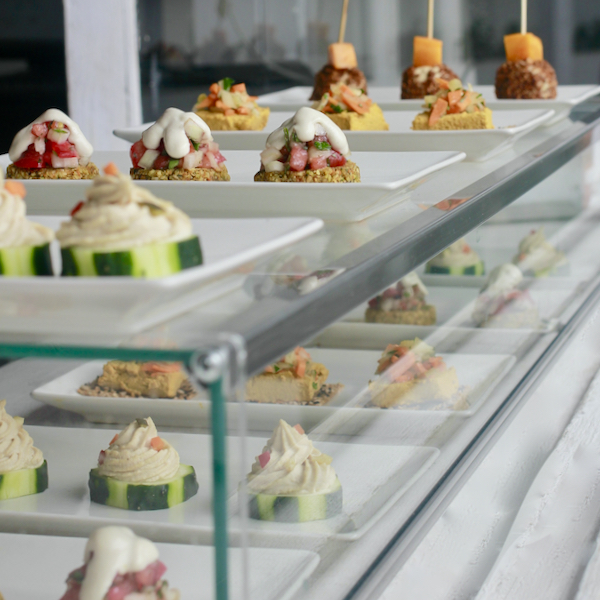
This week the Quotidian Cooks had a really disappointing experience at a sushi bar. We ended up leaving the place! We were drawn to the sushi bar after hearing about their reputation for using brown rice in their dishes. We were really interested in seeing how the whole rice would turn out in terms of flavor and texture when combined with fish. When looking at the menu we could only choose between tuna or salmon as fresh fish ingredients for the rolls, nigiris, and other types of sushi. So we asked the chef and he told us they used to have mackerel and sardines and other varieties of seasonal fish but clients tendered to only order tuna and salmon or salmon and tuna. And this is how a promising place ended up being a kind of boring, banal sushi bar.
We love sushi and sashimi preparations and we are very tired of seeing this massive use of salmon and tuna! We have serious doubts about the culinary integrity of both options. Blue fin tuna is permanently the number one species of fish on the red list of extinction and the vast majority of salmon is farmed under non-sustainable practices. We strongly suggest you watch the brilliant TED talk by Chef Dan Barber on why salmon is not a good option: How I fell in love with a fish.
How I fell in love with a fish. Dan Barber, 2010. TED TALKS.
Japanese food is among the healthiest on the planet as the legendary Okinawa Diet has showed us. But sushi, many times, has become a commercial trap and it tends to be disguised as healthy food when in reality unsustainable practices and not very clean ingredients are often used. Our take on this? Reject both types of fish and ask for local, seasonal fish species. We suggest you look for a reliable provider of farmed organic salmon if you want to eat it at home. The Slow Fish Initiative campaigns worldwide to help consumers and professional chefs to choose fair fish options. Check the Slow Fish guides here.
To recover from this experience the quotidians are bringing you a classical sashimi with leeks dish prepared with Bonito. Bonito (Katsuo in Japanese) is in season from June to September and in many areas is fished using traditional techniques. We will combine it with pickled leeks and ginger, a traditional side for katsuo and a celebration of the Okinawa Diet.
 To prepare the pickled leeks with ginger we are using a quick and easy technique of Japanese vegetable pickles, sokusekizuke (instant pickles) as they can be made and eaten within a day. It is ideal for cucumbers, carrots, radishes, or any other vegetable that we eat raw. The result is quite amazing: sour, fresh, a little spicy while retaining the crunchiness of the vegetables. The challenge here lies on your knife skills because you will need to slice the leeks and ginger in extremely thin strips.
To prepare the pickled leeks with ginger we are using a quick and easy technique of Japanese vegetable pickles, sokusekizuke (instant pickles) as they can be made and eaten within a day. It is ideal for cucumbers, carrots, radishes, or any other vegetable that we eat raw. The result is quite amazing: sour, fresh, a little spicy while retaining the crunchiness of the vegetables. The challenge here lies on your knife skills because you will need to slice the leeks and ginger in extremely thin strips.
This is a clean seasonal dish with a very Japanese palette of flavors and textures. The excellence of the bonito strips plays with the crunchy accents of the pickled vegetables. Enjoy it slowly! Ah, and do not forget to serve it with round, plump brown rice.
- 1 Lb Bonito, skin removed, deboned and filleted in four clean pieces.
- 1 Large leek
- 1 Ginger bulb 4-5 inches long
- Pickling marinade
- 1 Tbs. tamari
- 2 Tbs sake
- 1 tsp. mirin
- ¼ tsp. salt
- 1 Tbs. sugar
- 3 Tbs. rice vinegar
- Combine the pickling ingredients in a small pan. Heat up while stirring to dissolve the sugar and salt. Let come to a boil (to evaporate some of the alcohol) and let cool.
- Cut the top and tail of the leeks leaving off any green section
- Make a longitudinal cut and wash them carefully to get rid of any dirt between the leaves
- Cut the leeks in very thin strips of regular size (matchsticks)
- Cut the ginger piece in half and cut one half again in two pieces
- Peel one of the quarters and cut it into very thin slices
- Cut lengthwise in thin strips of the same size as the leeks (look at the picture in the post)
- Place the vegetables in a zip bag, lay it down flat on a plate, and put another plate on top. Weigh down with a weight on top of the upper plate. Let marinade in the refrigerator between 3-5 hours
- Check the bonito fillets for bones or skin pieces and remove them if necessary
- Cut the filets in 5 inch long by ½ inch slices. Make ½ inch by ½ inch strips as shown in the picture.
- Arrange the bonito with the vegetables on top and season with the pickling marinade.
The instant pickling time should be 3-5 hours but not more that 8 hours as vegs will turn quite sour. Eat the within 24 hours for freshness.
Make sure bonito is really fresh and be very careful about removing all bones before preparing the sashimi slices.












Leave a Reply